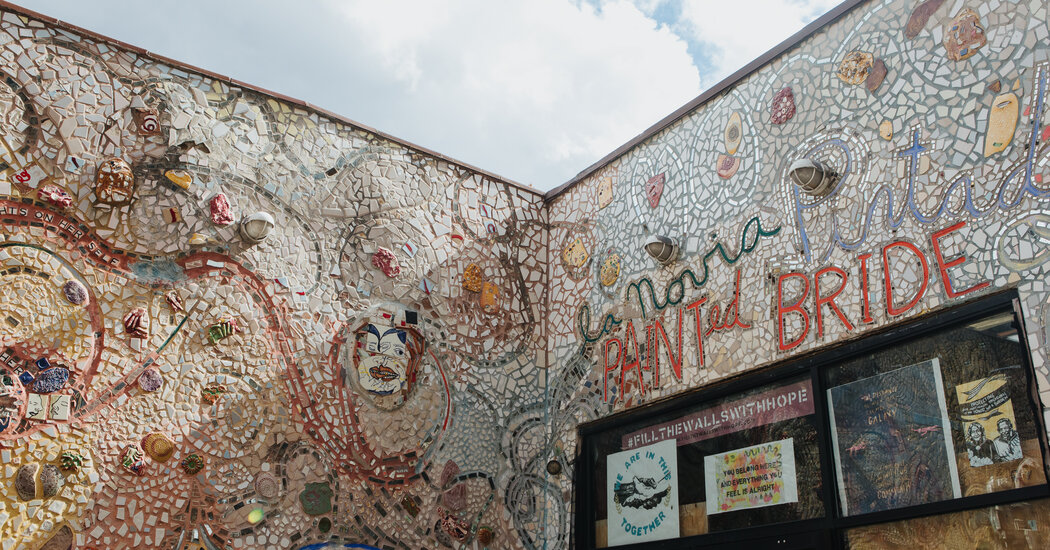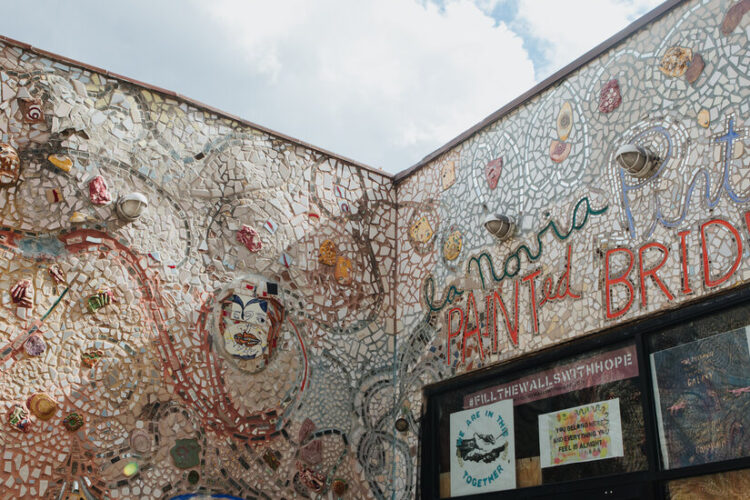
An architect said he could preserve a 7,000-square-foot mural if Old City allowed his new building to exceed height limits. After neighbors objected, a court ruled against him.
On an otherwise drab street in Philadelphia’s historic Old City, a multicolored mosaic made up of thousands of tiles and mirrored fragments creates swirling patterns, inscriptions and forms that honor the particular and invoke the mysterious.
The mosaic, which covers three sides of the former headquarters of the nonprofit Painted Bride Art Center, is the handiwork of Isaiah Zagar, who has created more than 200 works around the city since the late 1960s. He spent most of the 1990s on this mosaic, called “Skin of the Bride.”
Now the 20-foot building and the 7,000-square-foot mosaic at 230 Vine Street, blocks away from the Delaware River, are scheduled for demolition early next year to make way for a tower that will accommodate 85 short-term rental units or residential apartments.
A six-year legal battle over the mosaic’s fate illuminates the complicated decision-making facing cities that are anxious to ease housing crises and bolster tax bases with tall, modern buildings that some residents insist will ruin a neighborhood’s charm.
With urban space at a premium, how should it be used? And who gets to decide?
“I believe that we shouldn’t destroy beautiful things just because we can,” said Emily Smith, the executive director of Philadelphia’s Magic Gardens, a nonprofit set up by Zagar that represents him and other artists.
“I want to live in a world,” she added, “where I’m surprised and mystified by these unique, strange places.”
Philadelphia has an international reputation for public art, with some 4,000 murals on spaces of all kinds.
Seemingly random fragments of “Skin of the Bride” show a naked person jumping and a bird floating on the water. But the mosaic also includes specific references to the city: A story told on pink, yellow and gray tiles quotes from a Philadelphia Inquirer article about Abe Kravitz, a deceased horseradish vendor on South Street, a center of art and activism.
Ever since the Painted Bride Art Center announced it would sell its building and focus entirely on projects, the site of the mosaic has been the focus of several stakeholders, including Philadelphia’s Magic Gardens; nearby residents’ groups; the Philadelphia Historical Commission, which voted 5-4 against designating it a historic property; and the architect of the new residential building.
After first planning to demolish the former art center, the architect, Shimi Zakin, unveiled a design that would preserve “Skin of the Bride” while raising his building 20 feet higher than is allowed by the Old City neighborhood, the site of the Betsy Ross House and the Benjamin Franklin Museum.
But after complaints from area residents and the owner of a neighboring building, a Philadelphia court overturned a ruling by a local zoning board that allowed an exception to the height limit, saying the board had exceeded its authority.
Now Zakin again plans to tear down the art center, replacing it with a contemporary six-story structure — with floor-to-ceiling windows, a restaurant space and roof decks — on a street lined with brick buildings. He described the planned demolition of the mosaic as “heartbreaking” but said his building, which is expected to open in about three years, would not be financially feasible without the additional height.
“As an architect, I don’t just see the numbers behind a project,” said Zakin, the chief executive of Atrium Design Group. “I don’t start a project with an Excel sheet; I first want to make sure that I can do something that is meaningful. It’s a huge shame that I am not able to do that anymore.”
The tension between constructing new buildings and preserving existing artwork has been seen across the country: Last year, a 10-panel mural painted in the 1930s was removed intact from a doomed building at the University of California, San Francisco.
But oftentimes the art is destroyed. After a New York developer whitewashed the graffiti of 5Pointz, a canvas for graffiti artists, and replaced its industrial buildings with gleaming condominiums, a federal court ordered it to pay the artists $6.75 million. In Roxbury, Mass., a spray-painted mural of the anti-apartheid leader Nelson Mandela was demolished to make way for a 99-unit apartment building.
Some parts of Zagar’s mosaic in Philadelphia will be removed and preserved in other locations, Zakin said, but he acknowledged that most of it would be lost.
Zagar, now 84 and no longer working, said he regretted that it would not live on to lift the spirits of Philadelphians.
“I saw Shimi Zakin’s design as a wonderment; a brightness and excitement that he envisioned something new that was responding to my work,” Zagar said in a statement. “It would be a new place that people would go to be stimulated by art and architecture. Now the buildings are going up in Philadelphia at a rapid rate and they are ordinary glass boxes.”
Opponents of Zakin’s plan to build higher included Franklin Bridge North Neighbors, a community organization. Robert Gurmankin, the group’s president, said Zakin’s building would have been the tallest in the area except for a few century-old factory conversions.
Gurmankin’s group proposed saving the Vine Street side of the mosaic, which it said would have allowed for a less-expensive building that still complied with the zoning rules. “We will miss the mosaic and certainly did not oppose its preservation,” Gurmankin said.
Zakin said Gurmankin’s group had no experience in architecture or development that would have given merit to its proposal. “This group of people simply don’t want any development in their neighborhood,” he said.
The executive director of Mural Arts Philadelphia, a nonprofit that is partly funded by the city, said that the work of Zagar and others enhanced the public environment and helped create a sense of ownership for the city’s residents. She argued that public art could coexist with new development.
“While easing a housing shortage is undoubtedly essential, public art’s role in fostering community and cultural heritage is invaluable as well,” said the director, Jane Golden. “Why does it have to be one over the other? We are a big city. We can multitask, right?”
While some public art will inevitably be lost to development, Golden said, the planned demolition of Zagar’s mosaic is a special loss because of its beauty and what it represents.
“It is about history and memory and how art can become a beacon and a marker of time,” she said.

